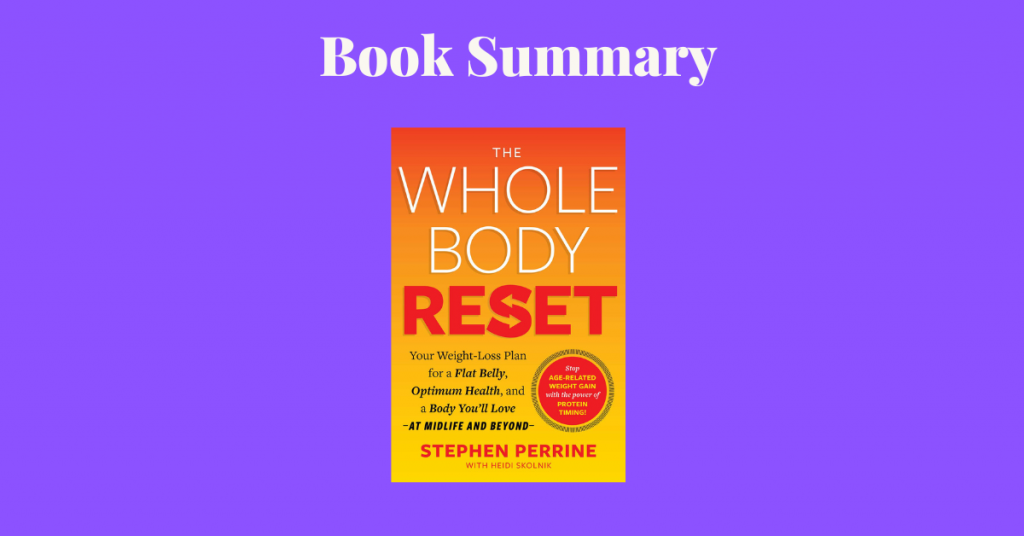The Whole Body Reset, is the result of a collaboration between Stephen Perrine, author of more than two dozen New York Times bestsellers and executive editor of AARP the Magazine and the AARP Bulletin, and Heidi Skolnik, nutritionist and exercise physiologist for legendary sports teams. In this entertaining and practical book, you’ll discover how to stay healthy and fit as you age by changing your diet and exercise habits.
Book Title: The Whole Body Reset: Your Weight-Loss Plan For A Flat Belly, Optimum Health, and a Body You’ll Love At Midlife And Beyond
Authors: Stephen Perrine with Heidi Skolnik
Date of Reading: May 2022
Rating: 9/10
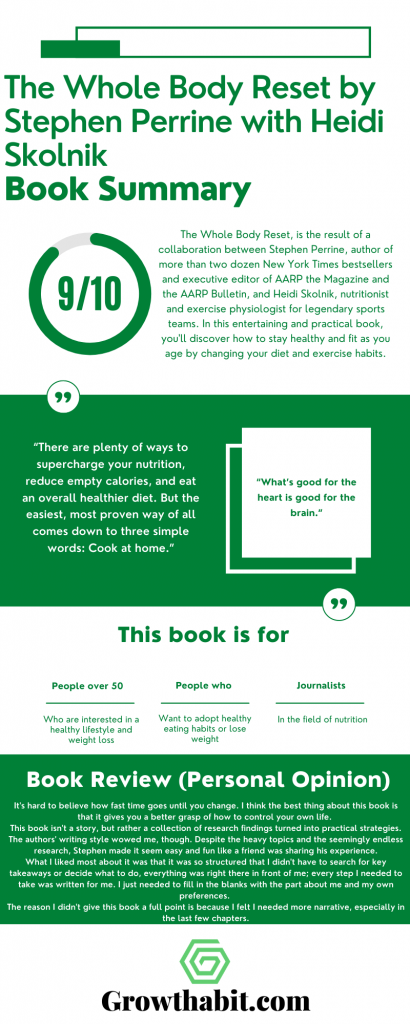
What Is Being Said In Detail:
This book discusses how to maintain a powerful and healthy body as we age. It offers advice on what foods to eat, what foods to avoid eating, when to eat, how to eat, and why to exercise. It emphasizes the importance of proper nutrition to maintain a youthful appearance and prevent age-related diseases.
There is an entire chapter in this book that explains how to read nutrition labels on foods in the supermarket and how to make a shopping list of foods that are rich in protein, fiber, and healthy fats without resorting to sugar and carbs that are empty calories, or satisfying but unhealthy fats.
Since this book provides a detailed breakdown of healthy foods on the menu of fast-food restaurants, not to mention their protein, fiber, and calorie content, it makes healthy eating possible even for the most ardent fast food lover.
Further, it critically evaluates a number of the most popular diets currently available on the market.
There is something for everyone in this book, from a seven-day meal plan, to a workout program designed to fit your fitness level, to plenty of recipes.
This book features 14 chapters plus a brief introduction and annexes. While each chapter is valuable on its own, it also ends with something you can do to ensure the theory works for you in the real world.
A Flat Belly At 50+
Introduction explains how the current national dietary guidelines fail to take into account the nutritional needs of people who are fifty and older.
The Age Defying Magic of Protein Timing
Chapter 1 of this book explains what protein timing is, as well as how it triggers your body to hold on to lean muscle tissue and spurn fat gain, especially in the elderly.
Our Changing Bodies, Our Changing Needs
Chapter 2 explores how the aging body begins to lose muscle and power, and how proper nutrition can reverse this process.
Let’s Spend A Day On The Whole Body Reset!
Chapter 3 provides a ready to use 7-Day Whole Body Reset Sample Menu and explains how to create an optimal menu that is high in protein and fiber.
The Six Simple Secrets of Better Health
Chapter 4 lists six rules that people might find helpful for maintaining good health as they get older, like choosing a protein-rich diet, eating dairy foods for their “complete” protein, and a variety of fruits and vegetables, and drinking clean water rather than empty calories to keep their health.
The Inside Story Of Your Gut
Chapter 5 examines the causes and consequences of belly fat, particularly how it is related to chronic inflammation that makes it difficult to digest food properly. It offers practical advice on how to replace foods that trigger inflammation with foods that soothe it. Also, it explains how fiber helps with digestion.
How The Whole Body Reset Can Help Fight Disease and Save Your Life (Over and Over Again)
Chapter 6 explains how the food and fitness components of this plan have been shown to reduce our risk of a remarkable number of health conditions and concerns, and can reduce our risk of pain, disability, and disease such as inflammation, colds, flu, diabetes, heart disease, and dementia.
How the Whole Body Reset Can Help Keep Your Mind Sharp
Chapter 7 discusses how your gut influences your brain function, why it’s important to eat a balanced diet, what it means to eat a breakfast, fruits, vegetables, cut your salt intake, and add more fish and fiber to your diet. This chapter explains how high muscle mass can keep the brain young.
Your Magic Supermarket Label Decoder
Chapter 8 discusses how to read the nutrition facts on food packages and choose healthy foods. It’s here that you’ll find tips on how to navigate the supermarket to find healthy foods and avoid the unhealthy ones that contain added sugar and bad fats.
Take Your Whole Body Out to Eat
Chapter 9 explains how to find and order healthy meals when you want to dine out. Here you can find a list of the menu items you can order in many fast food restaurants, along with their protein, fiber, and calorie contents.
Toss Out Your Old Diet Books
Chapter 10 summarizes the key points of every popular diet you might have heard of and explains why most of them do not work for older adults in the long run. Specifically, the article outlines how the Whole Body Reset program takes advantage of the most beneficial aspects of diet plans to help older people lose weight and maintain their health.
The Metabolism Myth
Chapter 11 discusses the importance of exercising regularly even if it does not necessarily assist with fat loss. It explains why you should not try to boost your metabolism. Instead, you should make sure it stays within a healthy range.
Your Whole Body Fitness Plan
Chapter 12 offers an exercise plan that can improve physical and mental health in people over 50. These workouts range from relatively easy to quite challenging.
Troubleshooting the Whole Body Reset
Chapter 13 explains the details of the Whole Body Reset program by presenting questions and answers from the test panel, made up of more than one hundred employees of AARP. It describes how lactose intolerant people can use this program, how to overcome the problems of emotional eating and binge eating, or how to proceed if you have a hard time eating fruits and vegetables, and more.
Whole Body Recipes
Chapter 14 provides recipes designed with the guidelines for the Whole Body Reset meaning getting enough protein, fiber, and keeping empty calories to a minimum. There are recipes for breakfast, smoothies, protein shakes, lunch and dinner entrees, sides, salads and soups, sauces and dressings, as well as snacks.
Most Important Keywords, Sentences, Quotes:
INTRODUCTION – A Flat Belly at 50+
“Many experts who study the nutritional needs of people fifty and older believe the current guidelines are so far off, they’re potentially unhealthy—a recipe for weight gain.
And the most surprising fact of all is that there’s plenty of science available to show exactly how we should eat to prevent age-related muscle loss, reverse age-related weight gain, and, most importantly, preserve our long-term health. It’s called “protein timing.”
“The Whole Body Reset applies up-to-the-minute weight-loss science—drawing from research primarily conducted not on animals, not on the general public, but on people our age.”
“It reveals how protein timing—eating protein in the proper amounts throughout the day—triggers older bodies to spurn fat gain and hold on to lean muscle tissue. This approach, coupled with plenty of fiber, vitamins and minerals, and healthy fats, can help us not only to reshape our bodies, but to reshape our very lives. It’s the foundation of the Whole Body Reset.”CHAPTER ONE – The Age-Defying Magic of Protein Timing
“All we need to do is to up our protein intake to 25 to 30 grams per meal, and our bodies respond the same way a younger person’s would.”
“For people at midlife, protein timing begins at breakfast. Indeed, research shows that women who eat less than 25 grams of protein in the morning (for men, it’s 30 grams) will probably be in muscle-loss mode all day.”
“That traditionally healthy breakfast, even if you’re eating the high-fiber oat-bran cereal your cardiologist recommends, isn’t, in fact, healthy enough. Not for someone your age (50+), or mine.”
CHAPTER TWO – Our Changing Bodies, Our Changing Needs
“[…] as we enter midlife, our bodies undergo an upgrade of sorts. They transition from old-school muscle cars—the type that run best on regular gas— to high-performance sports coupes. And high-performance vehicles require high-performance fuels.”
“When you were in your twenties, you could turn a glass of milk into muscle. Just a single cup of milk—with its 8 grams of protein—could get your body’s muscle-maintenance process revving.
But by the time we reach our thirties or so, we’ve already begun to see that ability fade—the aforementioned anabolic resistance. Metaphorically speaking, that glass of milk no longer boots up your muscle-building operating system. You need a bigger dose.
The “make muscle” button has to be pushed harder and harder as we get older in order to make the process turn on.”
“[…] you could call protein the building blocks of your whole body, since it’s also vital to dozens of tasks related to youth, vibrancy, and overall health: maintaining bone density, regulating blood sugar and hormone production, repairing damaged tissue, manufacturing collagen, supporting the immune system, keeping hair and nails strong, and more.”
“[…] the human body is constantly breaking down and building up muscle. But when the destruction of muscle outstrips its rate of repair over the long term, that eventually leads to a loss of muscle tissue. The scientific term for this gradual loss of muscle over the years is sarcopenia.”

“The loss of strength is caused in part by our aging nervous system. The “wires” that send signals throughout our bodies may not be able to transmit those signals as efficiently as they once did. Power is generated by speed. In our youth, we said “jump!” and our muscles asked “how high?”. As we get older, we say “jump!” and our muscles say, “er, what?””
“When your muscles wither, so do your opportunities to enjoy the world around you. Muscles are essential to keeping you upright and moving, independent and in control, for decades to come. And it’s not exaggerating to say they can save your life.”
“[…] the physiological changes […] illustrate exactly why we need to treat our older bodies as high-performance vehicles. We need greater amounts of nutrition for fewer calories, and we need to time our meals so we’re always in muscle-building mode.”
“The easiest way to add more nutrients into your day is to eat fewer processed foods (the stuff with lots of ingredients and empty calories) and more whole foods (the stuff with just one ingredient).”
“A simple way to eyeball protein is that a cooked portion of red meat or poultry should be a little bigger than the size of a deck of playing cards, while a portion of fish is about the size of a checkbook.”
CHAPTER THREE – Let’s Spend a Day on the Whole Body Reset!
“So there is no controversy, at least among the researchers who study age-related muscle loss: If you want to stay strong and active for years to come, eat a high-protein, fiber-packed breakfast every day.”
“Midday is when most of us make our biggest nutritional mistakes. We’re less than halfway through our day, we’re too busy or too bored, we’re distracted, and we just want the comfort of a delicious lunch to take the edge off our day.”
“In many cases, we can reach optimum eating just by adding a little more protein and a little more fiber to each meal.”
CHAPTER FOUR – The Six Simple Secrets of Better Health
“The keyword in the Whole Body Reset is consistency: How your body functions isn’t dictated by what you eat on any given day, but what you eat consistently, day in and day out.”
“[…] our bodies need 25 to 30 grams of protein—generally 25 grams for women, 30 for men—at each meal to keep the process of protein biosynthesis cranking along.”
“Well, it’s possible to eat lots of protein but still not get the essential muscle-building nutrients you need. What you’re looking for are “complete” proteins. A “complete” protein is one that delivers all nine “essential” amino acids— that is, those our bodies can’t make.”
“While our muscle-maintenance system is always humming along at some level, it can only kick in fully once it gets a jump start from the full complement of amino acids it needs.”
“As a source of complete protein, dairy is hard to beat. And as we get older, the benefits of milk, cheese, yogurt, and other forms of dairy only multiply.”
“[…] any diet plan that doesn’t include heaping portions of produce should immediately be filed away as a snake-oil cure.”
“While all vegetables are good for you—assuming they’re not coated with breading or deep-fried in oil—it helps to think of dark, leafy greens as the alpha veggies.”
“[…] fruits and vegetables help to reduce inflammation, … and inflammation is muscle’s enemy”
“[…] every additional gram of fiber the subjects ate correlated with a half a pound less in total weight, and a quarter percent less fat.”
“Fiber can help block calorie absorption.”
“Fiber supplements alone were ineffective at helping shed weight, according to one large study. The key is to pack our diet with fiber from a variety of grains, beans, and other plant foods.”
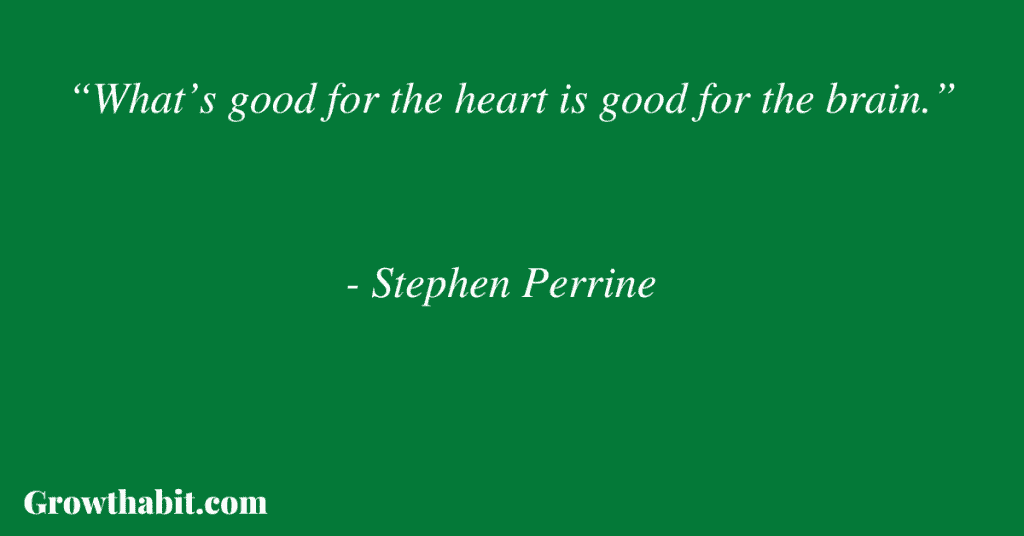
“[…] Fat from dairy may offer protection from cardiovascular diseases […]”
“[…] as our cells expand with proper fluid intake, the mitochondria may become more active, possibly increasing the rate of fat-burning and helping to lead to weight loss.”
“We have all sorts of excuses not to drink water […]. Which brings us back to your drinking habit: Start now by accompanying every meal with a big glass of water, sparkling water, or unsweetened coffee or tea. You’ll start another healthy habit for life.”
CHAPTER FIVE – The Inside Story Of Your Gut
“There’s a sort of triad of unhealthy aging—an “Axis of Evil,” as George W. Bush might put it. It’s the combination of diminished muscle quality, increased inflammation and expanding belly fat. They’re the Three Stooges of illness, each of them egging the other two on to greater and greater mischief. But in this confederacy of dunces, belly fat is the ringleader.”
“[…] visceral fat cells secrete higher levels of a molecule called RBP4, which increases insulin resistance, putting us at greater risk of diabetes and weight gain. Yes, belly fat causes you to gain belly fat.”
“The more visceral fat you have, the harder it is to prevent future weight gain.”
“inflammation is a response to cell damage—and fat cells are the body’s damsels in distress. They’re bloated with triglycerides (a substance similar to diesel fuel) and as a result, they are very fragile and can easily burst and die. When they do, they trigger an inflammatory response as the immune system sends white blood cells to clean up the spilled fuel.”
“As we age, the way our digestive system absorbs nutrients changes. It becomes harder and harder for us to get the vital nutrients we need from food, partly due to increased inflammation.”
CHAPTER SIX – How The Whole Body Reset Can Help Fight Disease and Save Your Life (Over And Over Again)
“[…] experts are looking at inflammation as the master manipulator of age-related health woes.”
“Low grade inflammation is linked to a multitude of diseases, from diabetes to cancer, but its effect on the immune system can be like a prankster who’s constantly pulling the fire alarm.
Your immune system responds, often inappropriately, attacking harmless invaders (think of how some people get allergic reactions to harmless substances, from pollen to peanuts) and even healthy body tissue.
After years of chasing after all these false calls, the immune system gets exhausted and distracted, and hence less capable of responding properly when a real fire alarm is unleashed.”
“A variety of things can trigger that low-grade inflammation, including genetics, diseases, and pollution. But age is the biggest contributor of all. It’s not just the natural changes in our bodies, but the accumulation of challenges we’ve put ourselves through: years of stress, lack of exercise, poor sleep, late nights in smoky bars—the bad-for-you stuff adds up over the decades.”
“[…] as our bodies age, and we have difficulty processing many of these nutrients —specifically vitamins, minerals, protein, and phytochemicals—those foods become less effective in helping us battle inflammation. We may be fighting disease with the same lightsaber, but the batteries aren’t fully charged.”
“[…] when you build muscle, you lower inflammation. Imagine belly fat and skeletal muscle in all our tug-of-war. The more you have of one, the more you are likely to have of the other.”
“Inflammation plays an enormous role in the health of your arteries, which is just one reason why loading your plate with a wide variety of colorful fruits and vegetables can make a big impact on whether or not your cardiologist gives you a passing grade.”
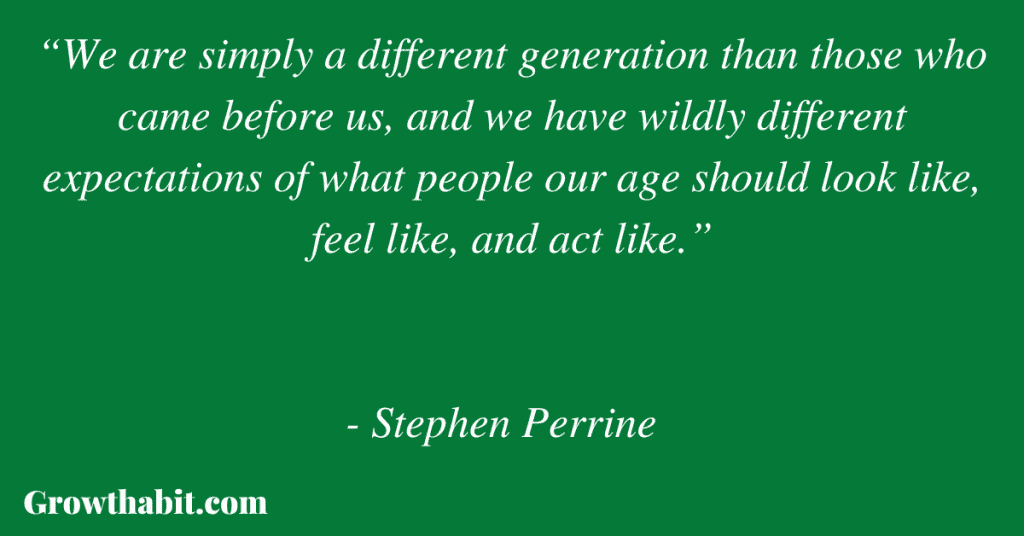
“Mobility is a vulnerable asset, and its loss isn’t always sudden. It starts with a creaky knee or a painful hip or an achy shoulder, and we learn to live with it, and adjust. But over time those accommodations to age pile up, until we’re no longer engaging in the physical activities we once enjoyed, whether it’s tennis or basketball or jogging or just gardening or taking long walks on the beach.”
CHAPTER SEVEN – How The Whole Body Reset Can Help Keep You Mind Sharp
“[…] what’s good for the heart is good for the brain.”
“A brain-healthy diet means a wide array of plant foods, with a particular emphasis on leafy greens, which are rich in the brain-boosting nutrient folate, as well as vitamin K, lutein, and beta carotene, all of which have been linked to slowing cognitive decline.”
“[…] berries have a special place in the brain health pantheon. Scores of studies on animals have shown that strawberries, blackberries, blueberries, black currants, and mulberries all reduce inflammation in the nervous system.”
“Regularly consuming sugary drinks leads to spiking blood sugar and an exaggerated insulin response, which can trigger chronic inflammation in the brain, making it vulnerable to Alzheimer’s.”
“[…] both memory and cognitive function decline faster with rising blood glucose levels.”
“Sugar in drinks damages the brain in the same way that sugary food damages the body: by, among other things, raising your levels of inflammation.”
“Brain health and heart health are both mediated by blood vessels, and what you eat determines whether those vessels will clog up or not. The same things that give rise to the clogging of the vessels in the heart may also give rise to clogging in the brain.”
“We have a considerable amount of influence on the direction of our short- and long-term brain health, and one of the most potent arrows in our quiver is diet. To stay sharp now and long into the future, you’ve to be in the right place.”
“If you’ve ever felt your stomach tied up in knots when you sit in traffic or filled up with butterflies before giving a talk, you’ve experienced the powerful effect of the enteric nervous system, often called the “brain in your gut”. This system is made up of the thousands of nerves that line the digestive tract and the same neurotransmitters, such as serotonin, that govern mood.”

“One study found that having low muscle mass was an indicator of low executive function— meaning, the ability to focus, stay organized, and generally run your life. It’s ironic, when you consider the stereotype of “dumb jocks,” to see how clearly retaining muscle mass is linked to retaining smarts.”
CHAPTER EIGHT – Your Magic Supermarket Label Decoder
“It works this way: When you’re evaluating any product, look at the grams of protein and the grams of protein and the grams of fiber. Add them together.
Now look at the grams of sugar. Which number is higher, the protein + fiber number, or the sugar number?”
“A lot of products are naturally loaded with protein and fiber, you’d probably assume they’d fit within this formula. But never underestimate food manufacturers’ ability to take something good, and make it not as good.”
CHAPTER NINE – Take Your Whole Body Out To Eat
“In an ideal world, every meal would be home-cooked, or thoughtfully prepared by chefs who had your health top of mind. In the real world, the tastebuds want what they want, and sometimes that means grabbing a quick meal out of a cardboard box or a clown’s mouth, or at the place you and your best pals have met at for twenty years.”
CHAPTER TEN – Toss out your old diet books
“We are simply a different generation than those who came before us, and we have wildly different expectations of what people our age should look like, feel like, and act like.”
“All we need is the knowledge of how to feed and care for our bodies, and the motivation to see it through. And yet… smart nutritional guidelines and effective weight-management programs for people our age are still difficult to come by.”
“[…] most popular eating plans—even if they’re relatively solid in terms of their overall contribution to wellness—fail to address the way our bodies change as we age.”
CHAPTER ELEVEN – The Metabolism Myth
“Our metabolism is set by the number of calories we need to survive. If we turned up our metabolism, we’d be increasing our risk of starvation. So nature protects us from that by keeping our metabolic rate constant, in spite of our attempts to burn calories through exercise.”
“If we do indeed face a dramatic shortage of calories, our bodies are capable of turning our metabolic rates down, causing us to burn fewer calories.”
“Deprive yourself of enough calories, and you reset your metabolic rate lower—which sets you up for future weight gain.”
“So, if exercise doesn’t cause us to burn additional calories, why should we do it? Because you are an athlete. And an athlete is always training.”
“You may not be able to “boost” your metabolism, but exercise can prevent it from slowing even further with age— and hence, help prevent illness and age-related weight gain.”
CHAPTER TWELVE – Your Whole Body Fitness Plan
“You’re at an age where you’ve earned the right to carve out half an hour a day for yourself. And here’s what you’re going to do with it: You’re going to take care of your body and mind through exercise.”
“What you’re not going to do, however, is worry about getting it exactly right. Every marathon starts with a first step. What matters right now is that you get into the habit of carving out time.”
CHAPTER THIRTEEN – Troubleshooting the Whole Body Reset
“If you wait until you are starving to eat, you are more likely to eat until you are stuffed. If you eat when you are moderately hungry, it is easier to stop when you are comfortably satisfied.
Be aware of when you’re no longer hungry; that is the signal that you have had enough, so get in the habit of paying attention to your body’s signals, and stop eating when the time comes.”
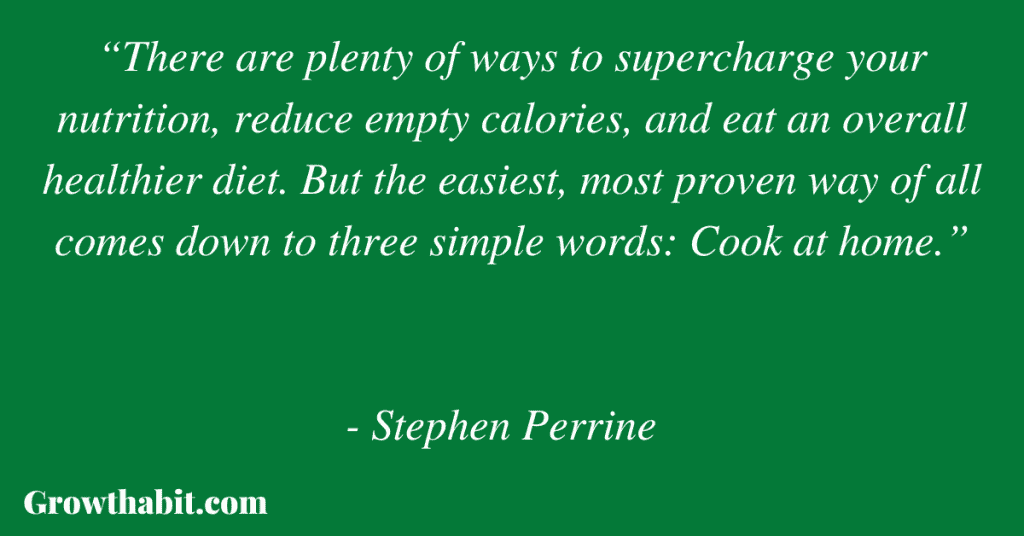
“[…] plate your food. Whether it is a meal or a snack, do not eat out of the container or bag. Place your portion on a plate. It helps to visually see what and how much you are eating. You can still have seconds!”
“Want more happiness? Try getting outside more often: In one study, researchers found that twenty minutes in a park boosted well-being.”
CHAPTER FOURTEEN – Whole Body Recipes
“There are plenty of ways to supercharge your nutrition, reduce empty calories, and eat an overall healthier diet. But the easiest, most proven way of all comes down to three simple words: Cook at home.”
“[…] it makes sense that you—and not some anonymous line cook at your local chain restaurant—should be the one in charge of what goes into your body.”
Book Review (Personal Opinion):
It’s hard to believe how fast time goes until you change. I think the best thing about this book is that it gives you a better grasp of how to control your own life.
This book isn’t a story, but rather a collection of research findings turned into practical strategies. The authors’ writing style wowed me, though. Despite the heavy topics and the seemingly endless research, Stephen made it seem easy and fun like a friend was sharing his experience.
What I liked most about it was that it was so structured that I didn’t have to search for key takeaways or decide what to do, everything was right there in front of me; every step I needed to take was written for me. I just needed to fill in the blanks with the part about me and my own preferences.
The reason I didn’t give this book a full point is because I felt I needed more narrative, especially in the last few chapters.
Rating: 9/10
This Book Is For:
- People over 50 who are interested in a healthy lifestyle and weight loss
- People who want to adopt healthy eating habits or lose weight
- Journalism in the field of nutrition
If You Want To Learn More
Here’s an interview with Stephen Perrine and Heidi Skolnik in which they discuss topics from The Whole Body Reset at 92Y May Center for Health, Fitness & Sport:
How I’ve Implemented The Ideas From The Book
Every chapter of the book is meant to be implemented, and that is exactly what I will be doing. At the moment, I am focusing on protein timing and adding lots of protein-rich foods to my diet, primarily dairy products, and fish. During the whole time, I read this book and wrote this summary, I never missed my breakfast.
One Small Actionable Step You Can Do
Find the chapter on reading nutrition facts on food and shopping for healthy foods at the supermarket. Next time when you are shopping, make a healthy choice and buy the items that are recommended in this book. The recipes in this book might be worth trying as well.
